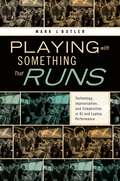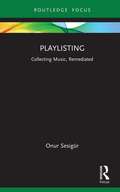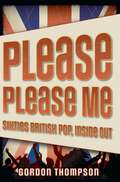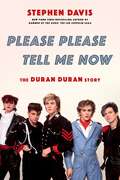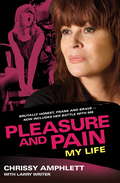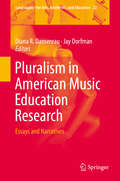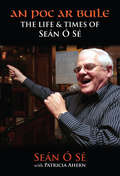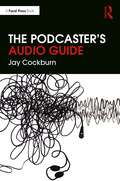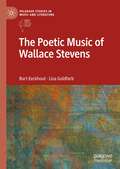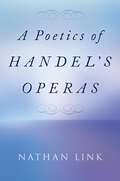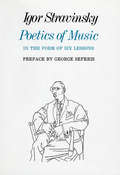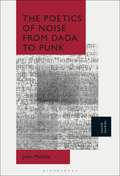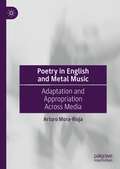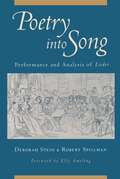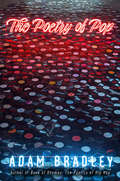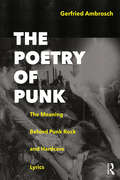- Table View
- List View
Playing with Something That Runs: Technology, Improvisation, and Composition in DJ and Laptop Performance
by Mark J. ButlerWinner of the 2015 PMIG Outstanding Publication Award from the Society of Music Theory The DJs and laptop performers of electronic dance music use preexistent elements such as vinyl records and digital samples to create fluid, dynamic performances. These performances are also largely improvised, evolving in response to the demands of a particular situation through interaction with a dancing audience. Within performance, musicians make numerous spontaneous decisions about variables such as which sounds they will play, when they will play them, and how they will be combined with other sounds. Yet the elements that constitute these improvisations are also fixed in certain fundamental ways: performances are fashioned from patterns or tracks recorded beforehand, and in the case of DJ sets, these elements are also physical objects (vinyl records). In Playing with Something That Runs, author Mark J. Butler explores these improvised performances, revealing the ways in which musicians utilize seemingly invariable prerecorded elements to create novel improvisations. Based on extensive interviews with musicians in their studios, as well as in-depth studies of particular mediums of performance, including both DJ and laptop sets, Butler illustrates the ways in which technologies, both material and musical, are used in performance and improvisation in order to make these transformations possible. An illuminating look at the world of popular electronic-music performance, Playing with Something that Runs is an indispensable resource for electronic dance musicians and fans as well as scholars and students of popular music.
Playing with Something That Runs: Technology, Improvisation, and Composition in DJ and Laptop Performance
by Mark J. ButlerWinner of the 2015 PMIG Outstanding Publication Award from the Society of Music Theory The DJs and laptop performers of electronic dance music use preexistent elements such as vinyl records and digital samples to create fluid, dynamic performances. These performances are also largely improvised, evolving in response to the demands of a particular situation through interaction with a dancing audience. Within performance, musicians make numerous spontaneous decisions about variables such as which sounds they will play, when they will play them, and how they will be combined with other sounds. Yet the elements that constitute these improvisations are also fixed in certain fundamental ways: performances are fashioned from patterns or tracks recorded beforehand, and in the case of DJ sets, these elements are also physical objects (vinyl records). In Playing with Something That Runs, author Mark J. Butler explores these improvised performances, revealing the ways in which musicians utilize seemingly invariable prerecorded elements to create novel improvisations. Based on extensive interviews with musicians in their studios, as well as in-depth studies of particular mediums of performance, including both DJ and laptop sets, Butler illustrates the ways in which technologies, both material and musical, are used in performance and improvisation in order to make these transformations possible. An illuminating look at the world of popular electronic-music performance, Playing with Something that Runs is an indispensable resource for electronic dance musicians and fans as well as scholars and students of popular music.
Playlisting: Collecting Music, Remediated (Routledge Focus on Digital Media and Culture)
by Onur SesigürThis book examines the collection and curation of music, and the way digital streaming services are transforming the way we engage with the media. The study foregrounds personal digital curation techniques, rather than algorithms or technology, to acknowledge the sustaining human agency involved in playlisting. The author looks at Digital Service Providers such as Spotify, Apple and Deezer, which offer their users not just access to large collections of music, but also the opportunity to create and maintain personalised consumption subsets such as playlists. Positioning these current playlisting practices as a remediation of significant cultural practices of the 20th century – such as collecting records and mix-taping – the book highlights the continuity of culture through media change, and the implications for concepts of self and identity, society and sharing. Shedding new light on this contemporary cultural phenomenon, this book will be an important read for scholars who are interested in the area of digital music from different disciplines such as communication, digital humanities and social sciences in fields of media studies, digital cultures, personal information management, digital curation and popular music.
Playlisting: Collecting Music, Remediated (Routledge Focus on Digital Media and Culture)
by Onur SesigürThis book examines the collection and curation of music, and the way digital streaming services are transforming the way we engage with the media. The study foregrounds personal digital curation techniques, rather than algorithms or technology, to acknowledge the sustaining human agency involved in playlisting. The author looks at Digital Service Providers such as Spotify, Apple and Deezer, which offer their users not just access to large collections of music, but also the opportunity to create and maintain personalised consumption subsets such as playlists. Positioning these current playlisting practices as a remediation of significant cultural practices of the 20th century – such as collecting records and mix-taping – the book highlights the continuity of culture through media change, and the implications for concepts of self and identity, society and sharing. Shedding new light on this contemporary cultural phenomenon, this book will be an important read for scholars who are interested in the area of digital music from different disciplines such as communication, digital humanities and social sciences in fields of media studies, digital cultures, personal information management, digital curation and popular music.
Please Please Me: Sixties British Pop, Inside Out
by Gordon ThompsonThe Beatles, the Rolling Stones, the Kinks, the Who, and numerous other groups put Britain at the center of the modern musical map. Please Please Me offers an insider's view of the British pop-music recording industry during the seminal period of 1956 to 1968, based on personal recollections, contemporary accounts, and all relevant data that situate this scene in the economic, political, and social context of postwar Britain. Author Gordon Thompson weaves issues of class, age, professional status, gender, and ethnicity into his narrative, beginning with the rise of British beat groups and the emergence of teenagers as consumers in postwar Britain, and moving into the competition between performers and the recording industry for control over the music. He interviews musicians, songwriters, music directors, and producers and engineers who worked with the best-known performers of the era. Drawing his interpretation of the processes at work during this musical revolution into a wider context, Thompson unravels the musical change and innovation of the time with an eye on understanding what traces individuals leave in the musical and recording process.
Please Please Me: Sixties British Pop, Inside Out
by Gordon ThompsonThe Beatles, the Rolling Stones, the Kinks, the Who, and numerous other groups put Britain at the center of the modern musical map. Please Please Me offers an insider's view of the British pop-music recording industry during the seminal period of 1956 to 1968, based on personal recollections, contemporary accounts, and all relevant data that situate this scene in the economic, political, and social context of postwar Britain. Author Gordon Thompson weaves issues of class, age, professional status, gender, and ethnicity into his narrative, beginning with the rise of British beat groups and the emergence of teenagers as consumers in postwar Britain, and moving into the competition between performers and the recording industry for control over the music. He interviews musicians, songwriters, music directors, and producers and engineers who worked with the best-known performers of the era. Drawing his interpretation of the processes at work during this musical revolution into a wider context, Thompson unravels the musical change and innovation of the time with an eye on understanding what traces individuals leave in the musical and recording process.
Please Please Tell Me Now: The Duran Duran Story
by Stephen DavisLifelong fans and interested newcomers will love this stunning biography of Duran Duran by the best-selling author of Gold Dust Woman and Hammer of the Gods. In Please Please Tell Me Now, best-selling rock biographer Stephen Davis tells the story of Duran Duran, the quintessential band of the 1980s. Their pretty boy looks made them the stars of fledgling MTV, but it was their brilliant musicianship that led to a string of number one hits. By the end of the decade, they had sold 60 million albums; today, they've sold over 100 million albums - and counting. Davis traces their roots to the austere 1970s British malaise that spawned both the Sex Pistols and Duran Duran - two seemingly opposite music extremes. Handsome, British, and young, it was Duran Duran that headlined Live Aid, not Bob Dylan or Led Zeppelin. The band moved in the most glamorous circles: Nick Rhodes became close with Andy Warhol, Simon LeBon with Princess Diana, and John Taylor dated quintessential British bad girl Amanda De Cadanet. With timeless hits like "Hungry Like the Wolf", "Girls on Film", "Rio", "Save a Prayer", and the best-selling James Bond theme in the series' history, "A View to Kill", Duran Duran has cemented its legacy in the pop pantheon - and with a new album and a worldwide tour on the way, they show no signs of slowing down anytime soon. Featuring exclusive interviews with the band, Please Please Tell Me Now offers a definitive account of one of the last untold sagas in rock and roll history - a treat for diehard fans, new admirers, and music lovers of any age.
Pleasure and Pain: My life
by Chrissy Amphlett Larry WriterChrissy Amphlett is a true legend of Australian rock’n’roll. Here, the spellbinding performer who inspired and outraged as lead singer of the Divinyls tells her own amazing story.In this raw, gripping and searingly honest account, Chrissy spares no one – least of all herself. She reveals how she formed the Divinyls and, with a unique voice, steely ambition and an outrageous stage act powered them to Australian and international stardom.Having battled alcohol, drugs and a million dollars worth of debt, Chrissy tells of her fight with MS and of finally finding peace with the love of her life in New York.Brave, sad, funny, ferocious, there's never been anyone like Chrissy Amphlett.
Pluralism in American Music Education Research: Essays and Narratives (Landscapes: the Arts, Aesthetics, and Education #23)
by Diana R. Dansereau Jay DorfmanThis volume examines pluralism in light of recent music education research history and pluralistic approaches in practice. Pluralistic research holds the potential to blend frameworks, foundations, methods, and analysis protocols, and leads to a sophisticated understanding of music teaching and learning. This blending could take place in a range of contexts that may span an individual study to a lifelong research agenda. Additionally, pluralistic ideals would guide the addressing of questions as a community. The volume also illuminates the work of innovative music education researchers who are constructing pluralistic research studies and agendas, and advocate for the music education profession to embrace such an approach in order to advance shared research goals. The ramifications of this transformation in music education research are a subject of discussion, including the implications for researcher education and the challenges inherent in conducting and disseminating such research.
An Poc Ar Buile: An Poc Ar Buile
by Seán Ó Sé Patricia AhernIn 1962 Seán Ó Sé recorded ‘An Poc ar Buile’ with Seán Ó Riada and Ceoltóirí Chualann. It proved a huge success and resulted in seven wonderful years working with Ó Riada and over sixty years of singing. Born in 1936, Seán grew up in west Cork not far from where his parents taught at Coomhola Boys’ School near Bantry. Following in his parents’ footsteps, Seán trained as a teacher and became Principal in Knocknaheeny on Cork city’s north side, remaining there until his retirement in 1993. Also recounted is Seán meeting his beloved Eileen, their family life and his struggle with cancer. Throughout it all, he sang. His singing career had taken off in 1959 when he won the traditional singing competition in Feis na Mumhan. It brought him to faraway places he could never have imagined growing up near Ballylickey in west Cork. * Also available: Seán Ó Riada by Tomás Ó Cannain
The Podcaster's Audio Guide
by Jay CockburnThe Podcaster's Audio Guide is a concise introduction to simple sound engineering techniques for podcasters. This digestible guide explains the basics of audio engineering, from equipment, to recording, editing, mixing and publishing. Suitable for beginners from all backgrounds, including students and hobbyists, as well as professional content producers looking to experiment with podcasts, The Podcaster's Audio Guide is the perfect resource with cheat sheets, starting set-ups and a comprehensive jargon buster.
The Podcaster's Audio Guide
by Jay CockburnThe Podcaster's Audio Guide is a concise introduction to simple sound engineering techniques for podcasters. This digestible guide explains the basics of audio engineering, from equipment, to recording, editing, mixing and publishing. Suitable for beginners from all backgrounds, including students and hobbyists, as well as professional content producers looking to experiment with podcasts, The Podcaster's Audio Guide is the perfect resource with cheat sheets, starting set-ups and a comprehensive jargon buster.
The Poetic Music of Wallace Stevens (Palgrave Studies in Music and Literature)
by Bart Eeckhout Lisa GoldfarbWallace Stevens’s musicality is so profound that scholars have only begun to grasp his ties to the art of music or the music of his own poetry. In this study, two long-time specialists present a polyphonic composition in which they pursue various interlocking perspectives. Their case studies demonstrate how music as a temporal art form may affect a poetic of ephemerality, sensuous experience, and affective intensification. Such a poetic, they argue, invites flexible interpretations that respond to poetry as an art of textual performance. How did Stevens enact the relation between music and memory? How can we hear his verse as a form of melody-making? What was specific to his ways of recording birdsong? Have we been missing the latent music of Richard Strauss, Gustav Mahler, and Claude Debussy in particular poems? What were the musical poetics he shared with Igor Stravinsky? And how is our experience of the late poetry transformed when we listen to a musical setting by Ned Rorem? The Poetic Music of Wallace Stevens will appeal to experts in the poet’s work, students of Modernism in the arts, and a wider audience fascinated by the dynamics of exchange between music and poetry.
A Poetics of Handel's Operas
by Nathan LinkWhat should we consider when thinking about the relationship between an onstage performance and the story the performance tells? A Poetics of Handel's Operas explores this question by analyzing the narratives of Handel's operas in relation to the rich representational fabric of performance used to convey them. Nathan Link notes that in most storytelling genres, the audience can naturally discern between a story and the way that story is represented: with film, for example, the viewer would recognize that a character hears neither her own voiceover nor the ambient music that accompanies it, whereas in discussions of opera, some audiences may be distracted by the seemingly artificial nature of such conventions as characters singing their dialogue. Link proposes that when engaging with opera, distinguishing between the performance we see and hear on the stage and the story represented offers a meaningful approach to engaging with and interpreting the work. Handel's operas are today the most-performed works in the Baroque opera seria tradition. This genre, with its intricate dramaturgy and esoteric conventions, stands to gain much from an investigation into the relationships between the onstage performance and the story to which that performance directs us. In his analysis, Link offers theoretical studies on opera and narratological theories of literature, drama, and film, providing rich engagement with Handel's work and what it conveys about the relationship between text, story, and performance.
A Poetics of Handel's Operas
by Nathan LinkWhat should we consider when thinking about the relationship between an onstage performance and the story the performance tells? A Poetics of Handel's Operas explores this question by analyzing the narratives of Handel's operas in relation to the rich representational fabric of performance used to convey them. Nathan Link notes that in most storytelling genres, the audience can naturally discern between a story and the way that story is represented: with film, for example, the viewer would recognize that a character hears neither her own voiceover nor the ambient music that accompanies it, whereas in discussions of opera, some audiences may be distracted by the seemingly artificial nature of such conventions as characters singing their dialogue. Link proposes that when engaging with opera, distinguishing between the performance we see and hear on the stage and the story represented offers a meaningful approach to engaging with and interpreting the work. Handel's operas are today the most-performed works in the Baroque opera seria tradition. This genre, with its intricate dramaturgy and esoteric conventions, stands to gain much from an investigation into the relationships between the onstage performance and the story to which that performance directs us. In his analysis, Link offers theoretical studies on opera and narratological theories of literature, drama, and film, providing rich engagement with Handel's work and what it conveys about the relationship between text, story, and performance.
Poetics of Music in the Form of Six Lessons (Charles Eliot Norton Lectures (hup) Ser. #2003)
by Igor StravinskyOne of the greatest of contemporary composers has here set down in delightfully personal fashion his general ideas about music and some accounts of his own experience as a composer. Every concert-goer and lover of music will take keen pleasure in his notes about the essential features of music, the process of musical composition, inspiration, musical types, and musical execution. Throughout the volume are to he found trenchant comments on such subjects as Wagnerism, the operas of Verdi, musical taste, musical snobbery, the influence of political ideas on Russian music under the Soviets, musical improvisation as opposed to musical construction, the nature of melody, and the function of the critic of music. Musical people of every sort will welcome this first presentation in English of an unusually interesting book.
The Poetics of Noise from Dada to Punk
by John MelilloBy reinterpreting 20th-century poetry as a listening to and writing through noise, The Poetics of Noise from Dada to Punk constructs a literary history of noise through poetic sound and performance. This book traces how poets figure noise in the disfiguration of poetic voice. Materializing in the threshold between the heard and the unheard, noise emerges in the differentiation and otherness of sound. It arises in the folding of an “outside” into the “inside” of poetic performance both on and off the page. Through a series of case studies ranging from verse by ear-witnesses to the First World War, Dadaist provocations, jazz modernist song and poetry, early New York City punk rock, contemporary sound poetry, and noise music, The Poetics of Noise from Dada to Punk describes productive failures of communication that theorize listening against the grain of sound's sense.
The Poetics of Noise from Dada to Punk
by John MelilloBy reinterpreting 20th-century poetry as a listening to and writing through noise, The Poetics of Noise from Dada to Punk constructs a literary history of noise through poetic sound and performance. This book traces how poets figure noise in the disfiguration of poetic voice. Materializing in the threshold between the heard and the unheard, noise emerges in the differentiation and otherness of sound. It arises in the folding of an “outside” into the “inside” of poetic performance both on and off the page. Through a series of case studies ranging from verse by ear-witnesses to the First World War, Dadaist provocations, jazz modernist song and poetry, early New York City punk rock, contemporary sound poetry, and noise music, The Poetics of Noise from Dada to Punk describes productive failures of communication that theorize listening against the grain of sound's sense.
The Poetics Of Rock: Cutting Tracks, Making Records
by Albin J. ZakZak looks at recording popular music as a form of composing; the laying down of tracks, mixing, mastering, and other engineering that go into making a recording are an integral part of creating a piece of popular music. Zak argues that the creation of popular music is by nature collaborative, with the recording studio as the site of collaboration.
Poetry in English and Metal Music: Adaptation and Appropriation Across Media
by Arturo Mora-RiojaMany metal songs incorporate poetry into their lyrics using a broad array of techniques, both textual and musical. This book develops a novel adaptation, appropriation, and quotation taxonomy that both expands our knowledge of how poetry is used in metal music and is useful for scholars across adaptation studies broadly. The text follows both a quantitative and a qualitative approach. It identifies 384 metal songs by 224 bands with intertextual ties to 146 poems written by fifty-one different poets, with a special focus on Edgar Allan Poe, John Milton's Paradise Lost and the work of WWI's War Poets. This analysis of transformational mechanisms allows poetry to find an afterlife in the form of metal songs and sheds light on both the adaptation and appropriation process and on the semantic shifts occasioned by the recontextualisation of the poems into the metal music culture. Some musicians reuse – and sometimes amplify – old verses related to politics and religion in our present times; others engage in criticism or simple contradiction. In some cases, the bands turn the abstract feelings evoked by the poems into concrete personal experiences. The most adventurous recraft the original verses by changing the point of view of either the poetic voice or the addressed actors, altering the vocaliser of the narrative or the gender of the protagonists. These mechanisms help metal musicians make the poems their own and adjust them to their artistic needs so that the resulting product is consistent with the expectations of the metal music culture.
Poetry into Song: Performance and Analysis of Lieder
by Deborah Stein Robert SpillmanFocusing on the music of the great song composers--Schubert, Schumann, Brahms, Wolf, and Strauss--Poetry Into Song offers a systematic introduction to the performance and analysis of Lieder . Part I, "The Language of Poetry," provides chapters on the themes and imagery of German Romanticism and the methods of analysis for German Romantic poetry. Part II, "The Language of the Performer," deals with issues of concern to performers: texture, temporality, articulation, and interpretation of notation and unusual rhythm accents and stresses. Part III provides clearly defined analytical procedures for each of four main chapters on harmony and tonality, melody and motive, rhythm and meter, and form. The concluding chapter compares different settings of the same text, and the volume ends with several appendices that offer text translations, over 40 pages of less accessible song scores, a glossary of technical terms, and a substantial bibliography. Directed toward students in both voice and theory, and toward all singers, the authors establish a framework for the analysis of song based on a process of performing, listening, and analyzing, designed to give the reader a new understanding of the reciprocal interaction between performance and analysis. Emphasizing the masterworks, the book features numerous poetic texts, as well as a core repertory of songs. Examples throughout the text demonstrate points, while end of chapter questions reinforce concepts and provide opportunities for directed analysis. While there are a variety of books on Lieder and on German Romantic poetry, none combines performance, musical analysis, textual analysis, and the interrelation between poetry and music in the systematic, thorough way of Poetry Into Song.
Poetry into Song: Performance and Analysis of Lieder
by Deborah Stein Robert SpillmanFocusing on the music of the great song composers--Schubert, Schumann, Brahms, Wolf, and Strauss--Poetry Into Song offers a systematic introduction to the performance and analysis of Lieder . Part I, "The Language of Poetry," provides chapters on the themes and imagery of German Romanticism and the methods of analysis for German Romantic poetry. Part II, "The Language of the Performer," deals with issues of concern to performers: texture, temporality, articulation, and interpretation of notation and unusual rhythm accents and stresses. Part III provides clearly defined analytical procedures for each of four main chapters on harmony and tonality, melody and motive, rhythm and meter, and form. The concluding chapter compares different settings of the same text, and the volume ends with several appendices that offer text translations, over 40 pages of less accessible song scores, a glossary of technical terms, and a substantial bibliography. Directed toward students in both voice and theory, and toward all singers, the authors establish a framework for the analysis of song based on a process of performing, listening, and analyzing, designed to give the reader a new understanding of the reciprocal interaction between performance and analysis. Emphasizing the masterworks, the book features numerous poetic texts, as well as a core repertory of songs. Examples throughout the text demonstrate points, while end of chapter questions reinforce concepts and provide opportunities for directed analysis. While there are a variety of books on Lieder and on German Romantic poetry, none combines performance, musical analysis, textual analysis, and the interrelation between poetry and music in the systematic, thorough way of Poetry Into Song.
The Poetry of Pop
by Adam BradleyA trailblazing exploration of the poetic power of popular songs, from Tin Pan Alley to the Beatles to Beyoncé and beyond. Encompassing a century of recorded music, this pathbreaking book reveals the poetic artistry of popular songs. Pop songs are music first. They also comprise the most widely disseminated poetic expression of our time. Adam Bradley traces the song lyric across musical genres from early twentieth-century Delta blues to mid-century rock 'n’ roll to today’s hits. George and Ira Gershwin’s “Fascinating Rhythm.” The Rolling Stones’ “(I Can’t Get No) Satisfaction.” Rihanna’s “Diamonds.” These songs are united in their exacting attention to the craft of language and sound. Bradley shows that pop music is a poetry that must be heard more than read, uncovering the rhythms, rhymes, and metaphors expressed in the singing voice. At once a work of musical interpretation, cultural analysis, literary criticism, and personal storytelling, this book illustrates how words and music come together to produce compelling poetry, often where we least expect it.
The Poetry of Punk: The Meaning Behind Punk Rock and Hardcore Lyrics
by Gerfried AmbroschPunk bands have produced an abundance of poetic texts, some crude, some elaborate, in the form of song lyrics. These lyrics are an ideal means by which to trace the developments and explain the conflicts and schisms that have shaped, and continue to shape, punk culture. They can be described as the community’s collective ‘poetic voice,’ and they come in many different forms. Their themes range from romantic love to emotional distress to radical politics. Some songs are intended to entertain, some to express strong feelings, some to provoke, some to spread awareness, and some to foment unrest. Most have an element of confrontation, of kicking against the pricks. Socially and epistemologically, they play a central role in the scene’s internal discourse, shaping communities and individual identities. The Poetry of Punk is an investigation into the Anglophone punk culture, specifically in the UK and the US, where punk originated in the mid-1970s, its focus being on the song lyrics written and performed by punk rock and hardcore artists.
The Poetry of Punk: The Meaning Behind Punk Rock and Hardcore Lyrics
by Gerfried AmbroschPunk bands have produced an abundance of poetic texts, some crude, some elaborate, in the form of song lyrics. These lyrics are an ideal means by which to trace the developments and explain the conflicts and schisms that have shaped, and continue to shape, punk culture. They can be described as the community’s collective ‘poetic voice,’ and they come in many different forms. Their themes range from romantic love to emotional distress to radical politics. Some songs are intended to entertain, some to express strong feelings, some to provoke, some to spread awareness, and some to foment unrest. Most have an element of confrontation, of kicking against the pricks. Socially and epistemologically, they play a central role in the scene’s internal discourse, shaping communities and individual identities. The Poetry of Punk is an investigation into the Anglophone punk culture, specifically in the UK and the US, where punk originated in the mid-1970s, its focus being on the song lyrics written and performed by punk rock and hardcore artists.
